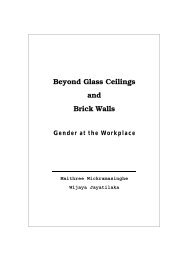SETP No. 14 The Economic Value of Incremental Employment in the ...
SETP No. 14 The Economic Value of Incremental Employment in the ...
SETP No. 14 The Economic Value of Incremental Employment in the ...
You also want an ePaper? Increase the reach of your titles
YUMPU automatically turns print PDFs into web optimized ePapers that Google loves.
3.23 <strong>The</strong>re are four possible reasons for <strong>the</strong>se results:<br />
• A small sample. <strong>The</strong> number <strong>of</strong> respondents for each category were:<br />
bricklayers – 2<strong>14</strong>, concrete workers – 17, carpenters – 91, labour – 241,<br />
and semi-skilled labour – 86.<br />
• A wide scatter <strong>in</strong> <strong>the</strong> data. This is evidenced by <strong>the</strong> very high standard<br />
deviations that are probably caused by <strong>the</strong> small sample <strong>of</strong> skilled<br />
workers.<br />
• Wages <strong>in</strong> <strong>the</strong> civil eng<strong>in</strong>eer<strong>in</strong>g <strong>in</strong>dustry be<strong>in</strong>g higher than house<br />
construction such that civil eng<strong>in</strong>eer<strong>in</strong>g labour does earn more house<br />
construction bricklayers.<br />
• <strong>The</strong> fall<strong>in</strong>g real wage for whites and coloureds is presumed to have a<br />
disproportional impact on skilled labour, contribut<strong>in</strong>g to extra deviations <strong>in</strong><br />
<strong>the</strong> sample<br />
<strong>The</strong> 1996 Census<br />
3.24 <strong>The</strong> recent general availability <strong>of</strong> <strong>the</strong> 1996 census allowed for a more reliable<br />
estimate <strong>of</strong> average wages by occupation type. Because <strong>of</strong> <strong>the</strong> very large<br />
sample – 40 million <strong>in</strong> <strong>the</strong>ory but 13 million <strong>in</strong> <strong>the</strong> ‘labour’ portion <strong>of</strong> <strong>the</strong><br />
community pr<strong>of</strong>ile – we expect to capture a more accurate measure <strong>of</strong> salaries<br />
by occupation.<br />
3.25 For <strong>the</strong> purposes <strong>of</strong> this <strong>in</strong>vestigation, <strong>the</strong> occupation categories <strong>of</strong> relevance are<br />
<strong>the</strong> five shown <strong>in</strong> Table 3.9 below – pr<strong>of</strong>essionals, technicians and associated<br />
pr<strong>of</strong>essionals, craft and related workers, plant and mach<strong>in</strong>e operators and<br />
assemblers, and elementary occupations. Of <strong>the</strong>se categories ‘craft and related<br />
workers’ is made up <strong>of</strong> categories 7122 (bricklayers), 7123 (concrete workers)<br />
and 7124 (carpenters) while ‘elementary occupations’ consists <strong>of</strong> 9312<br />
(construction labour) and 9312 (semi-skilled labour). <strong>The</strong> term ‘elementary<br />
occupations’ is used <strong>in</strong> <strong>the</strong> population census and is not a creation <strong>of</strong> this writer.<br />
National Estimates<br />
3.26 In Table 3.9 we show <strong>the</strong> full country results <strong>of</strong> an exam<strong>in</strong>ation <strong>of</strong> <strong>the</strong><br />
occupational structure <strong>of</strong> <strong>the</strong> construction <strong>in</strong>dustry and average salaries. <strong>The</strong> first<br />
column <strong>of</strong> <strong>the</strong> table <strong>in</strong>dicates <strong>the</strong> number <strong>of</strong> workers by occupation <strong>in</strong> <strong>the</strong> census<br />
sample. In <strong>the</strong>ory this sample should represent <strong>the</strong> occupation pr<strong>of</strong>ile <strong>of</strong> <strong>the</strong><br />
<strong>in</strong>dustry. Some concern is expressed at <strong>the</strong> large number <strong>of</strong> ‘craft and related<br />
workers’ relative to ‘elementary occupations’. <strong>The</strong> first impression is that this is<br />
counter <strong>in</strong>tuitive – construction labourers may have responded to <strong>the</strong> census<br />
questionnaire that <strong>the</strong>y are, for example, bricklayers. This k<strong>in</strong>d <strong>of</strong> response is a<br />
common problem with questionnaires. On <strong>the</strong> o<strong>the</strong>r hand Statistics SA has<br />
worked hard to avoid <strong>the</strong>se k<strong>in</strong>d <strong>of</strong> problems and it may be that <strong>the</strong> civil<br />
eng<strong>in</strong>eer<strong>in</strong>g part <strong>of</strong> <strong>the</strong> construction <strong>in</strong>dustry causes <strong>the</strong>se results but that <strong>the</strong><br />
results are correct <strong>in</strong> <strong>the</strong>mselves.<br />
3.27 <strong>The</strong>refore treat<strong>in</strong>g <strong>the</strong> results with due caution, we are able to report that <strong>in</strong> 1996<br />
<strong>the</strong> construction <strong>in</strong>dustry was made up <strong>of</strong> 486,000 workers. Of this 3% are<br />
pr<strong>of</strong>essionals, 4% are technicians, 73% are craft workers, 4% are mach<strong>in</strong>e<br />
operators and 17% are <strong>in</strong> elementary occupations.<br />
<strong>14</strong>
















